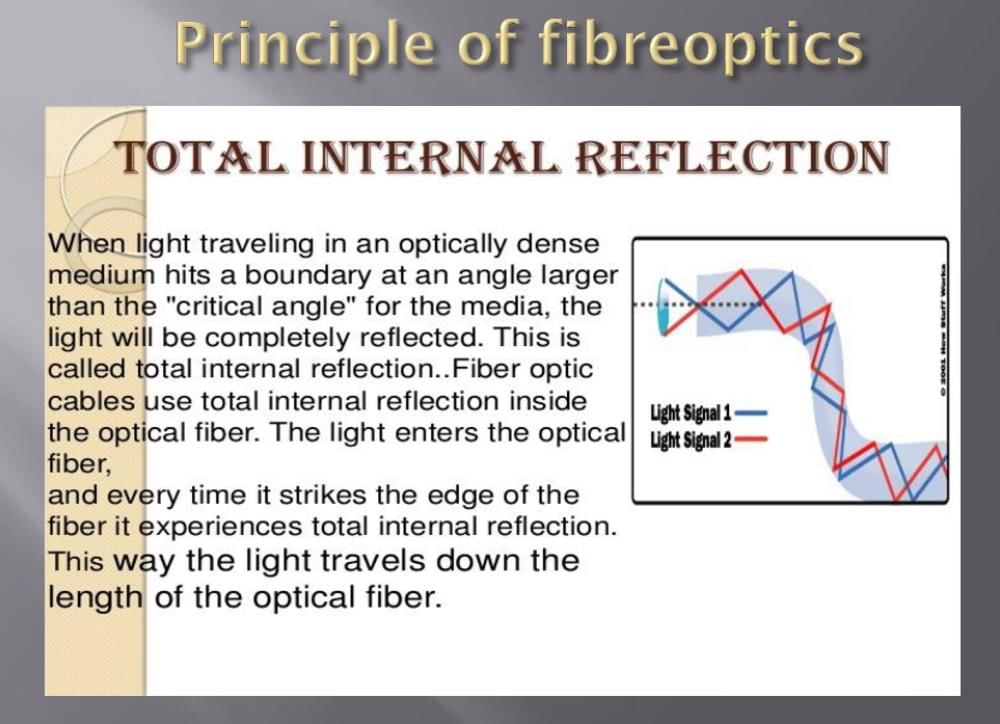All Exams >
Grade 9 >
AP Physics 2 >
All Questions
All questions of Optics for Grade 9 Exam
Two plane mirrors of length L are separated by distance L and a man M2 is standing at distance L from the connecting line of mirrors as shown in figure. A man M1 is walking in a straight line at distance 2L parallel to mirrors at speed u, then man M2 at O will be able to see image of M1 for total time : 
- a)

- b)

- c)

- d)

Correct answer is option 'C'. Can you explain this answer?
Two plane mirrors of length L are separated by distance L and a man M2 is standing at distance L from the connecting line of mirrors as shown in figure. A man M1 is walking in a straight line at distance 2L parallel to mirrors at speed u, then man M2 at O will be able to see image of M1 for total time :
a)
b)
c)
d)

|
Praveen Kumar answered |
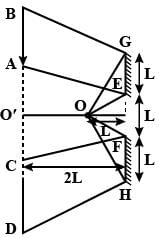
The light from man M1 hits the mirror and then reaches the man M2. The positions of the moving man need to be found when the light from him hits the corners of the mirror to reach the standing man.
From geometry,
AO′=L/2+2(L/2)
=3L/2
Similarly, BO′=(3L/2)+2(3L/2)
=9L/2
Hence AB=(9L/2)-(3L/2)=3/2
Time taken to cover this distance=3L/u
Similarly time taken to cover CD=3L/u
Thus total time he is visible is 6L/u
The focal length of a convex lens (refractive index = 1.5) in air is 20 cm. When immersed in water (refractive index = 1.33), its focal length will be- a)20.2cm
- b)78.23 cm
- c)7.23 cm
- d)2.02 cm
Correct answer is option 'B'. Can you explain this answer?
The focal length of a convex lens (refractive index = 1.5) in air is 20 cm. When immersed in water (refractive index = 1.33), its focal length will be
a)
20.2cm
b)
78.23 cm
c)
7.23 cm
d)
2.02 cm
|
|
Nikita Singh answered |
Focal length in air = 20 cm
Refractive index of air-water n₁= 1.33
Refractive index of air - glass n₂= 1.5
For focal length in air,
Using formula of lens
1/fair={(n2/n1)-1}(1/R1)-(1/R2)
Put the value into the formula
1/20={(1.5/1)-1}{(1/R1)-(1/R2)}
1/20=0.5{(1/R1)-(1/R2)}…1
We need to calculate the focal length in water
Using formula of lens
1/fwater={(1.5/1.33)-1}{(1/R1)-(1/R2)}
1/fwater=0.128{(1/R1)-(1/R2)}….2
fwater/20=0.5/0.128
fwater=78.125cm
Refractive index of air-water n₁= 1.33
Refractive index of air - glass n₂= 1.5
For focal length in air,
Using formula of lens
1/fair={(n2/n1)-1}(1/R1)-(1/R2)
Put the value into the formula
1/20={(1.5/1)-1}{(1/R1)-(1/R2)}
1/20=0.5{(1/R1)-(1/R2)}…1
We need to calculate the focal length in water
Using formula of lens
1/fwater={(1.5/1.33)-1}{(1/R1)-(1/R2)}
1/fwater=0.128{(1/R1)-(1/R2)}….2
fwater/20=0.5/0.128
fwater=78.125cm
Power of the lens is -40, its focal length is - a)4m
- b)-40m
- c)-0.25m
- d)-25m
Correct answer is option 'C'. Can you explain this answer?
Power of the lens is -40, its focal length is
a)
4m
b)
-40m
c)
-0.25m
d)
-25m
|
|
Jyoti Sengupta answered |
The power of a lens is the reciprocal of the focal length with measurement in metres. The unit is diopter.
It is given that the focal length of a convex lens is 10 cm = 0.1 m.
⇒ The power of the lens is 1/0.1= 10 diopter.
A convex and a concave mirror of radii 10 cm each are facing each other and 15 cm apart. A point object is placed midway between them. Then position of the final image if the reflection first takes place at the concave mirror and then in the convex mirror is- a)at the pole of the concave mirror
- b)at the pole of the convex mirror
- c)5 cm behind the convex mirror
- d)coincident with the object itself
Correct answer is option 'B'. Can you explain this answer?
A convex and a concave mirror of radii 10 cm each are facing each other and 15 cm apart. A point object is placed midway between them. Then position of the final image if the reflection first takes place at the concave mirror and then in the convex mirror is
a)
at the pole of the concave mirror
b)
at the pole of the convex mirror
c)
5 cm behind the convex mirror
d)
coincident with the object itself

|
Aayush Agarwal answered |
It will be best understood if you make a scale diagram. I will advice you do so and simultaneously read the answer. at first the reflection takes place at concave mirror. the objeCt is at a distance of 7.5cm from it. and 2.5cm from its focus. thereby the image shall be made in front of the mirror. next the image made will act as an object for the convex Mirror. and then it will make the image at its pole. if you arent still able to understand, do let me know
A thick plano convex lens made of crown glass (refractive index 1.5) has a thickness of 3cm at its centre. The radius of curvature of its curved face is 5cm. An ink mark made at the centre of its plane face, when viewed normally through the curved face, appears to be at a distance ‘x’ from the curved face. Then, x is equal to: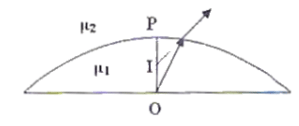
- a)2.5cm
- b)2.3cm
- c)2cm
- d)2.1cm
Correct answer is option 'A'. Can you explain this answer?
A thick plano convex lens made of crown glass (refractive index 1.5) has a thickness of 3cm at its centre. The radius of curvature of its curved face is 5cm. An ink mark made at the centre of its plane face, when viewed normally through the curved face, appears to be at a distance ‘x’ from the curved face. Then, x is equal to:
a)
2.5cm
b)
2.3cm
c)
2cm
d)
2.1cm

|
EduRev Humanities answered |
A thick Plano convex lens made of crown glass (refractive index 1.5) has a thickness of 3cm at its centre. The radius of curvature of its curved face is 5cm. An ink mark made at the centre of its plane face, when viewed normally through the curved face, appears to be at a distance ‘x’ from the curved face, and we have to determine the value of ' x'
According to the picture, the ray of light gets refracted at the interface between the air and the lens from the object 'p' and 'I' is the refracted image of 'p'
object distance 'u'= BO
Image distance 'v'/'x' = BI
we know
n2/v - n1/u = (n2- n1) / R
or 1/v - 1.5/(-3 )= (1-1.5)/ (-5) [where n2= 1, n1= 1.5 ,u= -3 ,R= -5]
so, 1/v = -6/15
or, v = -2.5
so, x is equal to 2.5 cm
According to the picture, the ray of light gets refracted at the interface between the air and the lens from the object 'p' and 'I' is the refracted image of 'p'
object distance 'u'= BO
Image distance 'v'/'x' = BI
we know
n2/v - n1/u = (n2- n1) / R
or 1/v - 1.5/(-3 )= (1-1.5)/ (-5) [where n2= 1, n1= 1.5 ,u= -3 ,R= -5]
so, 1/v = -6/15
or, v = -2.5
so, x is equal to 2.5 cm
______ mirror is called as diverging mirror- a)Concave
- b)Plane
- c)Convex
- d)Both b and c
Correct answer is option 'C'. Can you explain this answer?
______ mirror is called as diverging mirror
a)
Concave
b)
Plane
c)
Convex
d)
Both b and c
|
|
Preeti Iyer answered |
Concave mirror is called a converging mirror because parallel rays of light fall on the mirror they converge at a point called focus. Convex mirror is called a diverging mirror because parallel rays of light fall on it they diverge after reflection.
A prism of refractive index √2 and refractive angle A produces minimum deviation δm of a ray on one face at an angle of incidence 45°. The values of A and δm are respectively- a)45°, 45°
- b)60°, 30°
- c)60°, 45°
- d)45°, 60°
Correct answer is option 'B'. Can you explain this answer?
A prism of refractive index √2 and refractive angle A produces minimum deviation δm of a ray on one face at an angle of incidence 45°. The values of A and δm are respectively
a)
45°, 45°
b)
60°, 30°
c)
60°, 45°
d)
45°, 60°

|
Bs Academy answered |
μ=sinisinr
Again for minimum deviation
μ=sin(A+δmin2)sinA2
∴μ=sinisinA2
⇒sinA2=siniμ
⇒sinA2=sin45∘√2=12
⇒A2=30∘
⇒A=60∘
Again i+e=A+δmin
For minimum deviation i=e
∴2i=A+δmin
⇒δmin=2i−A
⇒δmin=2×45∘−60∘=30∘
A ray of light going from denser to rarer medium suffers refraction at a concave surface. Which of the following relations is correct?- a)

- b)

- c)

- d)

Correct answer is option 'A'. Can you explain this answer?
A ray of light going from denser to rarer medium suffers refraction at a concave surface. Which of the following relations is correct?
a)
b)
c)
d)

|
EduRev JEE answered |
Solution :
The correct option is Option A.
Laws of refraction;-
The incident ray,the refracted ray and the normal to the refracting surface at the point of incidence lie in the same plane.
For a given pair of media and for a given colour of light the ration between the sine of angle of incidence to the sine of refraction is a constant.This constant is known as refractive index of the second medium with respect to the first medium.
When a ray of light passes through a glass slab, ∠i,∠r and the normal all lie in the same plane.
When a ray of light passes from one medium to another, here from air to glass or glass to air, the ratio sini / sinr = constant.
Figure shows a plane mirror onto which a light ray is incident. If the incident light ray is turned by 10° and the mirror by 20°, as shown, find the angle turned by the reflected ray. 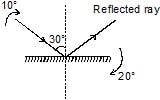
Correct answer is '30'. Can you explain this answer?
Figure shows a plane mirror onto which a light ray is incident. If the incident light ray is turned by 10° and the mirror by 20°, as shown, find the angle turned by the reflected ray.
|
|
Krishna Iyer answered |
The reflected ray will turn 100 due to incident ray and 400 due to mirror in opposite direction
∴ Net rotation =40−10
=300
Hence,
300 is the correct answer.
∴ Net rotation =40−10
=300
Hence,
300 is the correct answer.
A virtual image, larger than the object can be produced by- a)Convex mirror
- b)Concave mirror
- c)Plane mirror
- d)Concave lens
Correct answer is option 'B'. Can you explain this answer?
A virtual image, larger than the object can be produced by
a)
Convex mirror
b)
Concave mirror
c)
Plane mirror
d)
Concave lens
|
|
Ayaan Madhukar answered |
CONCAVE MIRROR...
Concave mirrors produce real and virtual, erect and inverted, diminished same size and magnified image depending upon the position of the object on the principal axis.
But the concave mirror forms a virtual and enlarged image when the object is placed between the focus and the pole of the mirror...
$$Hope it's help...$$
Concave mirrors produce real and virtual, erect and inverted, diminished same size and magnified image depending upon the position of the object on the principal axis.
But the concave mirror forms a virtual and enlarged image when the object is placed between the focus and the pole of the mirror...
$$Hope it's help...$$
The critical angle for the material of a prism is 45° and its refracting angle is 30°. A monochromatic ray goes out perpendicular to the surface of emergence from the prism. What is the angle of incidence on the prism?- a)60°
- b)75°
- c)30°
- d)45°
Correct answer is option 'D'. Can you explain this answer?
The critical angle for the material of a prism is 45° and its refracting angle is 30°. A monochromatic ray goes out perpendicular to the surface of emergence from the prism. What is the angle of incidence on the prism?
a)
60°
b)
75°
c)
30°
d)
45°

|
Sanchita Iyer answered |
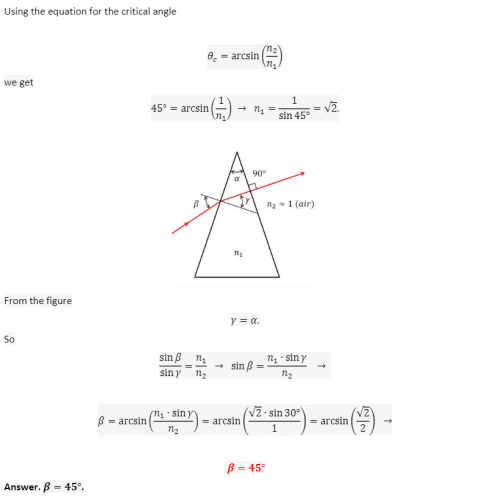
There are two plane mirror inclined at 40°, as shown. A ray of light is incident on mirror M1. What should be the value of angle of incidence 'i' so that the light ray retraces its path after striking the mirror M2. 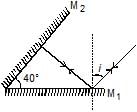
Correct answer is '40'. Can you explain this answer?
There are two plane mirror inclined at 40°, as shown. A ray of light is incident on mirror M1. What should be the value of angle of incidence 'i' so that the light ray retraces its path after striking the mirror M2.

|
Ciel Knowledge answered |
The ray strikes M2 normally
so r=90o-40o=50o
to the horizontal
=40 to the normal
As i=r
i=40o
so r=90o-40o=50o
to the horizontal
=40 to the normal
As i=r
i=40o
The radius of curvature of the left & right surface of the concave lens are 10 cm & 15 cm respectively. The radius of curvature of the mirror is 15 cm. 
- a)Equivalent focal length of the combination is –18 cm
- b)Equivalent focal length of the combination is +36 cm
- c)The system behaves like a concave mirror
- d)The system behaves like a convex mirror.
Correct answer is option 'A,C'. Can you explain this answer?
The radius of curvature of the left & right surface of the concave lens are 10 cm & 15 cm respectively. The radius of curvature of the mirror is 15 cm.
a)
Equivalent focal length of the combination is –18 cm
b)
Equivalent focal length of the combination is +36 cm
c)
The system behaves like a concave mirror
d)
The system behaves like a convex mirror.

|
New Words answered |
Peq=2PL1+2PL2+PM
=(2/fL1)+2(1/fL2)-(1/fM)
Peq=-2(1/12)+(4/45)-(2/-15)
Peq=1/18
-1/f=1/18
F=-18cm
Here the system acts as a concave mirror.
=(2/fL1)+2(1/fL2)-(1/fM)
Peq=-2(1/12)+(4/45)-(2/-15)
Peq=1/18
-1/f=1/18
F=-18cm
Here the system acts as a concave mirror.
A thin prism P1 with angle 4° and made from glass of refractive index 1.54 is combined with another thin prism P2 made from glass of refractive index 1.72 to produce dispersion without deviation . The angle of prism P2 is:- a)5.33°
- b)2.6°
- c)3°
- d)4°
Correct answer is option 'C'. Can you explain this answer?
A thin prism P1 with angle 4° and made from glass of refractive index 1.54 is combined with another thin prism P2 made from glass of refractive index 1.72 to produce dispersion without deviation . The angle of prism P2 is:
a)
5.33°
b)
2.6°
c)
3°
d)
4°
|
|
Rajat Kapoor answered |
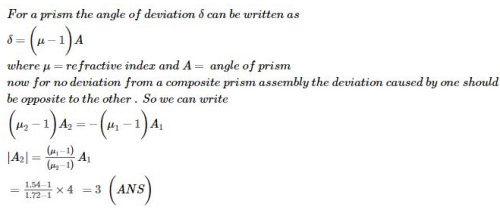
In a concave mirror when the object is located beyond C the magnification is- a)More than 1
- b)Equal to 1
- c)Less than 1
- d)Both a and b
Correct answer is option 'C'. Can you explain this answer?
In a concave mirror when the object is located beyond C the magnification is
a)
More than 1
b)
Equal to 1
c)
Less than 1
d)
Both a and b
|
|
Rajeev Saxena answered |
In the animation above, a right-side-up object is located above the principal axis at a position beyond the center of curvature (C). The ray diagram shows that the image of this object is located as an upside-down image positioned between the center of curvature (C) and the focal point (F). In fact, it can be generalized that anytime the object is located beyond the center of curvature, the image will be located somewhere between the center of curvature and the focal point. In such cases, the image will be inverted and reduced in size (i.e., smaller than the object). Such images are called real images because they are formed by the actual convergence of reflected light rays at the image location. Real images are always formed on the same side of the mirror as the object.
Variation of focal length to form a sharp image on retina is called- a)accommodation
- b)aperture
- c)retina control
- d)sutter
Correct answer is option 'A'. Can you explain this answer?
Variation of focal length to form a sharp image on retina is called
a)
accommodation
b)
aperture
c)
retina control
d)
sutter
|
|
Om Desai answered |
The ability of the eye in terms of variation of the focal length to form sharp images on the retina is called accommodation.
In simpler terms, the ability of the eye to change the focus from a near distance or a far distance is called accommodation of the eye.
It is possible because of the lens which changes its shape. This makes it possible for the eye to keep focus on an object even when its distance from the eye changes.
In simpler terms, the ability of the eye to change the focus from a near distance or a far distance is called accommodation of the eye.
It is possible because of the lens which changes its shape. This makes it possible for the eye to keep focus on an object even when its distance from the eye changes.
Light is confined within the core of a simple optical fiber by:- a)total internal reflection at the outer edge of the cladding.
- b)reflection from the fiber’s plastic coating.
- c)total internal reflection at the core cladding boundary.
- d)refraction
Correct answer is option 'C'. Can you explain this answer?
Light is confined within the core of a simple optical fiber by:
a)
total internal reflection at the outer edge of the cladding.
b)
reflection from the fiber’s plastic coating.
c)
total internal reflection at the core cladding boundary.
d)
refraction
|
|
Riya Banerjee answered |
Light remains confined within the core of simple optical fibre because of Total internal reflection from core cladding boundary.
Light is confined within the core of a simple optical fiber by. If light hits a boundary of a material of lower refractive index at a steep enough angle, it cannot get out and it's reflected back into the high index medium, as in the figure below.
An optical fibre is a thin rod of high-quality glass. Very little light is absorbed by the glass.Optical fibres can carry more information than an ordinary cable of the same thickness. The signals in optical fibres do not weaken as much over long distances as the signals in ordinary cables.
Total internal reflection. When light traveling in an optically dense medium hits a boundary at a steep angle (larger than the critical angle for the boundary), the light is completely reflected. This effect is used in optical fibers to confine light in the core.
The light in a fiber-optic cable travels through the core (hallway) by constantly bouncing from the cladding (mirror-lined walls), a principle called total internal reflection. Because the cladding does not absorb any light from the core, the light wave can travel great distances.
Light is confined within the core of a simple optical fiber by. If light hits a boundary of a material of lower refractive index at a steep enough angle, it cannot get out and it's reflected back into the high index medium, as in the figure below.
An optical fibre is a thin rod of high-quality glass. Very little light is absorbed by the glass.Optical fibres can carry more information than an ordinary cable of the same thickness. The signals in optical fibres do not weaken as much over long distances as the signals in ordinary cables.
Total internal reflection. When light traveling in an optically dense medium hits a boundary at a steep angle (larger than the critical angle for the boundary), the light is completely reflected. This effect is used in optical fibers to confine light in the core.
The light in a fiber-optic cable travels through the core (hallway) by constantly bouncing from the cladding (mirror-lined walls), a principle called total internal reflection. Because the cladding does not absorb any light from the core, the light wave can travel great distances.
Total internal reflection occurs when- a)Angle of incidence is equal to critical angle
- b)Angle of incidence is greater than critical angle
- c)Total internal reflection doesn’t depend on angle of incidence or critical angle
- d)Angle of incidence is less than critical angle
Correct answer is option 'B'. Can you explain this answer?
Total internal reflection occurs when
a)
Angle of incidence is equal to critical angle
b)
Angle of incidence is greater than critical angle
c)
Total internal reflection doesn’t depend on angle of incidence or critical angle
d)
Angle of incidence is less than critical angle

|
Rounak Goyal answered |
Total internal reflection is the phenomenon which occurs when a propagated wave strikes a medium boundary at an angle larger than a particular critical angle with respect to the normal to the surface.The critical angle is the angle of incidence above which the total internal reflection occurs.
Magnifying power of a compound microscope is high if- a)the objective has a long focal length and eye-piece has a short focal
- b)the objective has a short focal length and the eye-piece has a long
- c)both objective and eye-piece have short focal lengths
- d)both objective and eye-piece have long focal lengths
Correct answer is option 'C'. Can you explain this answer?
Magnifying power of a compound microscope is high if
a)
the objective has a long focal length and eye-piece has a short focal
b)
the objective has a short focal length and the eye-piece has a long
c)
both objective and eye-piece have short focal lengths
d)
both objective and eye-piece have long focal lengths

|
Ciel Knowledge answered |
Magnifying power of a compound- microscope is given by m=− (lD/f0fe)
where, l is length of tube
D is least distance of clear vision
f0 is focal length of objective
fe is focal length of eyepiece
So, clearly, it can be seen that focal length of objective and eyepiece needs to be decreased so that magnifying power increases.
where, l is length of tube
D is least distance of clear vision
f0 is focal length of objective
fe is focal length of eyepiece
So, clearly, it can be seen that focal length of objective and eyepiece needs to be decreased so that magnifying power increases.
When light is reflected from a mirror a change occurs in its- a)phase,
- b)frequency,
- c)wavelength,
- d)speed
Correct answer is option 'A'. Can you explain this answer?
When light is reflected from a mirror a change occurs in its
a)
phase,
b)
frequency,
c)
wavelength,
d)
speed

|
Ramesh Chand answered |
When a light wave is reflected from an object , it changes not only it's amplitude but also its phase according to the properties of the object at a particular point. Therefore, option A is the right answer.
An object is placed at a distance of 10 cm from a co-axial combination of two lenses A and B in contact. The combination forms a real image three times the size of the object. If lens B is concave with a focal length of 30 cm, what is the nature and focal length of lens A ?- a)Concave, 12 cm
- b)Convex, 18 cm
- c)Convex, 12 cm
- d)Convex, 6 cm
Correct answer is option 'D'. Can you explain this answer?
An object is placed at a distance of 10 cm from a co-axial combination of two lenses A and B in contact. The combination forms a real image three times the size of the object. If lens B is concave with a focal length of 30 cm, what is the nature and focal length of lens A ?
a)
Concave, 12 cm
b)
Convex, 18 cm
c)
Convex, 12 cm
d)
Convex, 6 cm
|
|
Riya Banerjee answered |
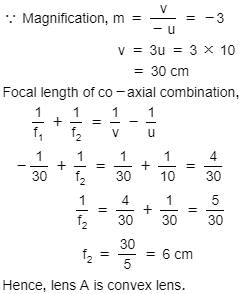
Find the angle of deviation (clockwise) suffered by a ray incident on a plane mirror, at an angle of incidence 30°. 
Correct answer is '240'. Can you explain this answer?
Find the angle of deviation (clockwise) suffered by a ray incident on a plane mirror, at an angle of incidence 30°.
|
|
Krishna Iyer answered |
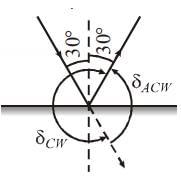
δ ACW = 180° – 60°
= 120° Anticlockwise
δ CW = 180° + 60°
= 240° Clockwise
If R1 and R2 are the radii of curvature of a double convex lens, which of the following will have the largest power?- a)R1 = 10 cm and R2 = ∞
- b)R1 = R2 = 5 cm
- c)R1 = ∞ and R2 = 10 cm
- d)R1 = R2 = 10 cm
Correct answer is option 'B'. Can you explain this answer?
If R1 and R2 are the radii of curvature of a double convex lens, which of the following will have the largest power?
a)
R1 = 10 cm and R2 = ∞
b)
R1 = R2 = 5 cm
c)
R1 = ∞ and R2 = 10 cm
d)
R1 = R2 = 10 cm
|
|
Nikita Singh answered |
Using the lens maker’s formula we get
p= (μ−1) (1/R1+1/R2)
As we can clearly see, when R1= R2= 5cm then the maximum power is achieved.
p= (μ−1) (1/R1+1/R2)
As we can clearly see, when R1= R2= 5cm then the maximum power is achieved.
In image formation from spherical mirrors, only paraxial rays are considered because they- a)are easy to handle geometrically
- b)contain most of the intensity of the incident light
- c)form nearly a point image of a point source
- d)show minimum dispersion effect.
Correct answer is option 'C'. Can you explain this answer?
In image formation from spherical mirrors, only paraxial rays are considered because they
a)
are easy to handle geometrically
b)
contain most of the intensity of the incident light
c)
form nearly a point image of a point source
d)
show minimum dispersion effect.
|
|
Riya Banerjee answered |
Paraxial rays are ones which originate from a point source and make a small angle with the principal axis. After reflection, they give a point image, either real or virtual.
But if rays from point source that are far from the mirror axis, gives a blurred image, an effect called spherical aberration.
But if rays from point source that are far from the mirror axis, gives a blurred image, an effect called spherical aberration.
The objective of a telescope has a focal length of 1.2 m. It is used to view a 10.0 m tall tower 2 km away. What is the height of the image of the tower formed by the objective?- a)8 mm
- b)2 mm
- c)6 mm
- d)4 mm
Correct answer is option 'C'. Can you explain this answer?
The objective of a telescope has a focal length of 1.2 m. It is used to view a 10.0 m tall tower 2 km away. What is the height of the image of the tower formed by the objective?
a)
8 mm
b)
2 mm
c)
6 mm
d)
4 mm
|
|
Lavanya Menon answered |
α (Radian)=10/2000=1/200rad
α=h/F=h/1.2
h= α x 1.2
h=(1/200) x1.2 cm
=6mm
α=h/F=h/1.2
h= α x 1.2
h=(1/200) x1.2 cm
=6mm
The bluish color predominates in a clear sky,- a)Since blue has a is radiated much more strongly
- b)Since blue has a longer wavelength than red and is scattered much more strongly
- c)Since blue has a shorter wavelength than red and is scattered much more strongly
- d)Since blue has a shorter wavelength than red and is scattered much less strongly
Correct answer is option 'C'. Can you explain this answer?
The bluish color predominates in a clear sky,
a)
Since blue has a is radiated much more strongly
b)
Since blue has a longer wavelength than red and is scattered much more strongly
c)
Since blue has a shorter wavelength than red and is scattered much more strongly
d)
Since blue has a shorter wavelength than red and is scattered much less strongly
|
|
Suresh Kumar answered |
Sky is blue because of scattering of light of minimum wavelength i.e blue by the dust particles suspended in the air. so option c is correct
A plano-convex lens, when silvered on the plane side, behaves like a concave mirror of focal length 30 cm. When it is silvered on the convex side, it behaves like a concave mirror of focal length 10 cm. The refractive index of the material of the lens is
- a)2.0
- b)2.5
- c)1.5
- d)3.0
Correct answer is option 'C'. Can you explain this answer?
A plano-convex lens, when silvered on the plane side, behaves like a concave mirror of focal length 30 cm. When it is silvered on the convex side, it behaves like a concave mirror of focal length 10 cm. The refractive index of the material of the lens is
a)
2.0
b)
2.5
c)
1.5
d)
3.0

|
Gauri Kaur answered |
3. 1.5
Solution: Let the radius of curvature of the convex surface of the plano-convex lens be RRR. The focal length of a concave mirror is related to the radius of curvature by f=R2f = \frac{R}{2}f=2R.
-
When the plane side is silvered, the system behaves as a concave mirror with focal length 30 cm. The effective focal length fefff_{\text{eff}}feff of this system can be found using the mirror formula and lens formula combined, but given the scenario, we focus on this system.
-
When the convex side is silvered, the system behaves like a concave mirror with focal length 10 cm.
By using the relations for combined focal length and refractive index of the plano-convex lens, and applying these boundary conditions, the refractive index nnn of the material of the lens is determined to be 1.5.
Two mirrors are placed perpendicular to each other. A ray strikes the first mirror and after reflection from the first mirror it falls on the second mirror. The ray after reflection from second mirror will emerge- a)Perpendicular to the original ray
- b)Parallel to the original ray
- c)At 450 to the original ray
- d)At 600 to the original ray
Correct answer is option 'B'. Can you explain this answer?
Two mirrors are placed perpendicular to each other. A ray strikes the first mirror and after reflection from the first mirror it falls on the second mirror. The ray after reflection from second mirror will emerge
a)
Perpendicular to the original ray
b)
Parallel to the original ray
c)
At 450 to the original ray
d)
At 600 to the original ray
|
|
Preeti Iyer answered |
Let ray strikes the vertical mirror by angle of incidence θ. Then by joining the perpendiculars of two mirrors it is clear from the diagram that angle of incidence at the horizontal mirror is (90−θ).
∴ reflected ray from the horizontal mirror makes angle θ with the horizontal mirror also incident ray at vertical mirror makes angle θ with horizontal axis.
∴ reflected ray is parallel to the original ray.
This is true for two perpendicular mirrors fixed at any positions.
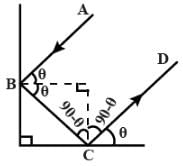
∴ reflected ray from the horizontal mirror makes angle θ with the horizontal mirror also incident ray at vertical mirror makes angle θ with horizontal axis.
∴ reflected ray is parallel to the original ray.
This is true for two perpendicular mirrors fixed at any positions.

If an object is placed unsymmetrically between two plane mirrors, inclined at the angle of 600, then the total number of images formed is- a)5
- b)4
- c)2
- d)infinite
Correct answer is option 'A'. Can you explain this answer?
If an object is placed unsymmetrically between two plane mirrors, inclined at the angle of 600, then the total number of images formed is
a)
5
b)
4
c)
2
d)
infinite
|
|
Hansa Sharma answered |
The number of images between two plane mirror inclined at an angle θ when the object is placed symmetrically between the mirrors is given as
n=(360o/ θ) −1
Given,
θ=60o
∴n=(360o/60)−1=6−1=5
n=(360o/ θ) −1
Given,
θ=60o
∴n=(360o/60)−1=6−1=5
Which of the following cannot form real image of a real object ?
- a)Concave mirror
- b)Convex mirror
- c)Plane mirror
- d)Diverging lens
Correct answer is option 'B'. Can you explain this answer?
Which of the following cannot form real image of a real object ?
a)
Concave mirror
b)
Convex mirror
c)
Plane mirror
d)
Diverging lens
|
|
Lavanya Menon answered |
A concave mirror can form both real and virtual images depending upon the distance between object and mirror.
A convex mirror can only form virtual, erect, and diminished images; therefore, it is true that it can never form a real image of a real object.
-Virtual image cannot be formed from a virtual object.
- When an object is placed between pole and focus, the image formed by the concave mirror is magnified, virtual and erect.
-When an object is placed beyond the centre of curvature , image of it is formed between centre of curvature and focus which is diminished,real and inverted,so real image of real object can be formed by concave mirror.
-When the object is virtual, the image formed is real for the concave surface as shown in figure.
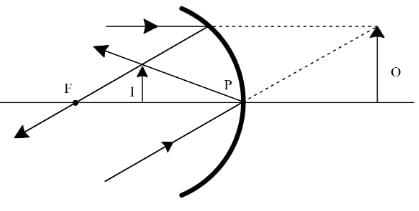
Which of the following letters do not surface lateral inversion- a)HGA
- b)HOX
- c)VET
- d)YUL
Correct answer is option 'B'. Can you explain this answer?
Which of the following letters do not surface lateral inversion
a)
HGA
b)
HOX
c)
VET
d)
YUL
|
|
Hansa Sharma answered |
Lateral inversion-The phenomenon of left side appearing right side and right side appearing left side on reflection in a plane mirror is called lateral inversion.
Letters that do not show lateral inversion are,
A, H, I, M, O, T, U, V, W, X, Y
Hence, HOX will not show lateral inversion.
Letters that do not show lateral inversion are,
A, H, I, M, O, T, U, V, W, X, Y
Hence, HOX will not show lateral inversion.
Which is the position of minimum deviation in prism?- a)When the angle of incidence is such that the refracted ray inside the prism is perpendicular to the base of the prism.
- b)When the angle of incidence is such that the refracted ray inside the prism is parallel to the base of the prism.
- c)When the angle of incidence is such that the refracted ray inside the prism reflects back from the base of the prism.
- d)When the angle of incidence is such that the refracted ray inside the prism is at 45 degrees to the base of the prism.
Correct answer is option 'B'. Can you explain this answer?
Which is the position of minimum deviation in prism?
a)
When the angle of incidence is such that the refracted ray inside the prism is perpendicular to the base of the prism.
b)
When the angle of incidence is such that the refracted ray inside the prism is parallel to the base of the prism.
c)
When the angle of incidence is such that the refracted ray inside the prism reflects back from the base of the prism.
d)
When the angle of incidence is such that the refracted ray inside the prism is at 45 degrees to the base of the prism.
|
|
Priyanshu Pandey answered |
A prism is said to be in the position of minimum deviation when the angle of incidence of the light ray at the first prism surface is equal to the angle of emergence at the second surface of prism. In this condition, the refracted ray inside the prism is parallel to the base of the prism.
Find the angle of deviation (anticlockwise) suffered by a ray incident on a plane mirror, at an angle of incidence 30°. 
Correct answer is '120'. Can you explain this answer?
Find the angle of deviation (anticlockwise) suffered by a ray incident on a plane mirror, at an angle of incidence 30°.
|
|
Lavanya Pamujula answered |
Angle of deviation is given by a formula : = π-2i. where π =180 degrees ,i=angle of incidence
The ratio of angular dispersion of to the angle of deviation for the mean wavelength is called Dispersive Power. Represented by
- a)

- b)

- c)

- d)

Correct answer is option 'A'. Can you explain this answer?
The ratio of angular dispersion of to the angle of deviation for the mean wavelength is called Dispersive Power. Represented by
a)
b)
c)
d)
|
|
Om Desai answered |
The dispersive power(ω)Of a prism is defined as the ratio of angular dispersion to the mean deviation produced by the prism,
Mean deviation=��
Angular dispersion= ��v- ��y
Dispersive power=angular dispersion/mean deviation
Dispersive power= ��v- ��y/ ��
Mean deviation=��
Angular dispersion= ��v- ��y
Dispersive power=angular dispersion/mean deviation
Dispersive power= ��v- ��y/ ��
For a rectangular slab, refraction takes place at- a)Two interfaces
- b)Three interfaces
- c)Four interfaces
- d)One interfaces
Correct answer is option 'A'. Can you explain this answer?
For a rectangular slab, refraction takes place at
a)
Two interfaces
b)
Three interfaces
c)
Four interfaces
d)
One interfaces
|
|
Saanvi Bose answered |
Refraction in a Rectangular Slab
In a rectangular slab, refraction takes place at two interfaces.
Explanation:
- A rectangular slab can be considered as a prism with a rectangular cross-section.
- When a ray of light enters the slab from air (or any other medium), it undergoes refraction at the first interface between air and the slab.
- The angle of incidence and the angle of refraction are related by Snell's law: n1 sinθ1 = n2 sinθ2, where n1 and n2 are the refractive indices of air and the slab, respectively, and θ1 and θ2 are the angles of incidence and refraction, respectively.
- The refracted ray travels through the slab and undergoes refraction again when it exits the slab and enters air (or any other medium).
- The angle of incidence and the angle of refraction at the second interface are related by Snell's law in a similar manner.
- Therefore, refraction takes place at two interfaces in a rectangular slab.
Conclusion:
Refraction in a rectangular slab takes place at two interfaces, one when the ray enters the slab and another when it exits the slab.
In a rectangular slab, refraction takes place at two interfaces.
Explanation:
- A rectangular slab can be considered as a prism with a rectangular cross-section.
- When a ray of light enters the slab from air (or any other medium), it undergoes refraction at the first interface between air and the slab.
- The angle of incidence and the angle of refraction are related by Snell's law: n1 sinθ1 = n2 sinθ2, where n1 and n2 are the refractive indices of air and the slab, respectively, and θ1 and θ2 are the angles of incidence and refraction, respectively.
- The refracted ray travels through the slab and undergoes refraction again when it exits the slab and enters air (or any other medium).
- The angle of incidence and the angle of refraction at the second interface are related by Snell's law in a similar manner.
- Therefore, refraction takes place at two interfaces in a rectangular slab.
Conclusion:
Refraction in a rectangular slab takes place at two interfaces, one when the ray enters the slab and another when it exits the slab.
Newtonian reflecting type telescope uses- a)Concave mirror
- b)Convex lens
- c)Concave lens
- d)Convex mirror
Correct answer is option 'B'. Can you explain this answer?
Newtonian reflecting type telescope uses
a)
Concave mirror
b)
Convex lens
c)
Concave lens
d)
Convex mirror
|
|
Ishan Choudhury answered |
A reflecting telescope (also called a reflector) is a telescope that uses a single or a combination of curved mirrors that reflect light and form an image. The reflecting telescope was invented in the 17th century, by Isaac Newton, as an alternative to the refracting telescope which, at that time, was a design that suffered from severe chromatic aberration. Although reflecting telescopes produce other types of optical aberrations, it is a design that allows for very large diameter objectives.
Astronomical (reflecting) telescopes. In a reflecting telescope, instead of a convex objective lens, a concave mirror is used to collect parallel rays from the object and form an image at the focal point. Then the convex eyepiece lens is used to magnify this image for the viewer.
Critical angle is- a)The angle of refraction in the denser medium corresponding to which the angle of incidence in the rarer medium is 90°.
- b)The angle of incidence in the denser medium corresponding to which the angle of refraction in the rarer medium is 0°.
- c)The angle of incidence in the denser medium corresponding to which the angle of refraction in the rarer medium is 90°.
- d)The angle of incidence in the rarer medium corresponding to which the angle of refraction in the denser medium is 90°
Correct answer is option 'C'. Can you explain this answer?
Critical angle is
a)
The angle of refraction in the denser medium corresponding to which the angle of incidence in the rarer medium is 90°.
b)
The angle of incidence in the denser medium corresponding to which the angle of refraction in the rarer medium is 0°.
c)
The angle of incidence in the denser medium corresponding to which the angle of refraction in the rarer medium is 90°.
d)
The angle of incidence in the rarer medium corresponding to which the angle of refraction in the denser medium is 90°
|
|
Kalyan Joshi answered |
Understanding the Critical Angle
The critical angle is an important concept in optics, particularly in the study of refraction. It refers to the specific angle of incidence in a denser medium at which light, upon reaching the interface with a rarer medium, will refract at an angle of 90 degrees.
Key Definitions
- Denser Medium: A medium with a higher refractive index (e.g., glass).
- Rarer Medium: A medium with a lower refractive index (e.g., air).
Explanation of the Critical Angle
- Refraction Basics: When light travels from one medium to another, it bends at the interface. The angle of incidence is the angle between the incoming light ray and the normal (perpendicular) to the surface.
- Critical Angle: This is defined as:
- The angle of incidence in the denser medium where the angle of refraction in the rarer medium is exactly 90 degrees.
- At this angle, the refracted ray runs along the boundary of the two media. Any incidence angle greater than this will result in total internal reflection.
Why Option C is Correct
- Since the question states: “The angle of incidence in the denser medium corresponding to which the angle of refraction in the rarer medium is 90 degrees,” it accurately describes the critical angle.
- Options A and B refer to angles of refraction or incidence that do not align with the definition of the critical angle.
Conclusion
Understanding the critical angle is essential for applications like fiber optics and understanding natural phenomena like rainbows. It plays a crucial role in determining how light behaves at the interface between different media.
The critical angle is an important concept in optics, particularly in the study of refraction. It refers to the specific angle of incidence in a denser medium at which light, upon reaching the interface with a rarer medium, will refract at an angle of 90 degrees.
Key Definitions
- Denser Medium: A medium with a higher refractive index (e.g., glass).
- Rarer Medium: A medium with a lower refractive index (e.g., air).
Explanation of the Critical Angle
- Refraction Basics: When light travels from one medium to another, it bends at the interface. The angle of incidence is the angle between the incoming light ray and the normal (perpendicular) to the surface.
- Critical Angle: This is defined as:
- The angle of incidence in the denser medium where the angle of refraction in the rarer medium is exactly 90 degrees.
- At this angle, the refracted ray runs along the boundary of the two media. Any incidence angle greater than this will result in total internal reflection.
Why Option C is Correct
- Since the question states: “The angle of incidence in the denser medium corresponding to which the angle of refraction in the rarer medium is 90 degrees,” it accurately describes the critical angle.
- Options A and B refer to angles of refraction or incidence that do not align with the definition of the critical angle.
Conclusion
Understanding the critical angle is essential for applications like fiber optics and understanding natural phenomena like rainbows. It plays a crucial role in determining how light behaves at the interface between different media.
Mark the correct options- a)If the incident rays are converging, we have a real object.
- b)If the final rays are converging, we have a real image.
- c)The image of a virtual object is called a virtual image.
- d)If the image is virtual, the corresponding object is called a virtual object
Correct answer is option 'B'. Can you explain this answer?
Mark the correct options
a)
If the incident rays are converging, we have a real object.
b)
If the final rays are converging, we have a real image.
c)
The image of a virtual object is called a virtual image.
d)
If the image is virtual, the corresponding object is called a virtual object
|
|
Geetika Shah answered |
If the final rays are converging, we have a real image.
This is because a real image is formed by converging reflected/refracted rays from a mirror/lens.
The correct answer is option B.
This is because a real image is formed by converging reflected/refracted rays from a mirror/lens.
The correct answer is option B.
A light ray is incident on a plane mirror, which after getting reflected strikes another plane mirror, as shown in figure. The angle between the two mirrors is 60°. Find the angle 'q' shown in figure. 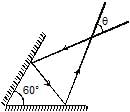
Correct answer is '60'. Can you explain this answer?
A light ray is incident on a plane mirror, which after getting reflected strikes another plane mirror, as shown in figure. The angle between the two mirrors is 60°. Find the angle 'q' shown in figure.

|
Sushil Kumar answered |
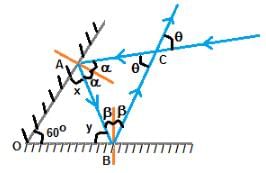
Figure shows two plane mirrors kept at angle 60°. A light ray incidents at A making an angle of incidence α,
reflected and again incidents at B making an angle β and getting reflected .
Reflected ray from B makes angle θ with the initial incident ray.
At reflection point A, as shown in figure, we have α+x = 90° ..............(1)
At reflection point B, as shown in figure, we have β+y = 90° ..............(2)
By adding (1) and (2), after substituting x+y = 120°, we get, α+β = 60° ...............(3)
From ΔABC, we have, 2α + 2β + θ = 180° ...................(4)
Hence By using eqn.(3), we get , θ = 180 - 120 = 60°
The focal length of spherical mirror is- a)Maximum for red light
- b)Maximum for blue light
- c)Maximum for white light
- d)Same for all lights
Correct answer is option 'D'. Can you explain this answer?
The focal length of spherical mirror is
a)
Maximum for red light
b)
Maximum for blue light
c)
Maximum for white light
d)
Same for all lights
|
|
Lavanya Menon answered |
Focal length is the property of a spherical mirror. It does not depend on the light used. So, it is the same for all lights.
An image is upright and reduced in size. Which mirror is used to form such an image?- a)Convex
- b)Concave
- c)Plane
- d)Both a and c
Correct answer is option 'D'. Can you explain this answer?
An image is upright and reduced in size. Which mirror is used to form such an image?
a)
Convex
b)
Concave
c)
Plane
d)
Both a and c
|
|
Nikita Singh answered |
Only Convex Mirror can form an image which is upright and reduced in size.
A convex lens produces a real image m times the size of the object. What is the distance of the object from the lens?- a)(m + 1)f
- b)

- c)(m – 1)f
- d)

Correct answer is option 'D'. Can you explain this answer?
A convex lens produces a real image m times the size of the object. What is the distance of the object from the lens?
a)
(m + 1)f
b)
c)
(m – 1)f
d)
|
|
Rajesh Gupta answered |
M=−ϑ /u =−m/1
ϑ=−mu
(1/ϑ)−(1/u)=1/f
1/mu+1/u=−1/f
(1+m)/xu=−1/f
u= (1+m)f/(m)
ϑ=−mu
(1/ϑ)−(1/u)=1/f
1/mu+1/u=−1/f
(1+m)/xu=−1/f
u= (1+m)f/(m)
Dispersive power is dependent on- a)Material of prism
- b)Angle of prism
- c)Length of prism
- d)Angle of emergence of the ray of light
Correct answer is option 'A'. Can you explain this answer?
Dispersive power is dependent on
a)
Material of prism
b)
Angle of prism
c)
Length of prism
d)
Angle of emergence of the ray of light
|
|
Naina Bansal answered |
Dispersive power of a prism depends only on the nature of material of the prism.However angular dispersion and mean deviation, both depend on angle of prism.
An observer looks at a tree of height 15 metre with a telescope of magnifying power 10. To him, the tree appears- a)15 times nearer
- b)10 times nearer
- c)15 times taller
- d)10 times taller
Correct answer is option 'B'. Can you explain this answer?
An observer looks at a tree of height 15 metre with a telescope of magnifying power 10. To him, the tree appears
a)
15 times nearer
b)
10 times nearer
c)
15 times taller
d)
10 times taller

|
Juhi Deshpande answered |
The angle subtended at the eye becomes 10 times larger.This happens only when the tree appears 10 times nearer.
The magnifying power of the telescope can be increased by- a)increasing the focal length of eyepiece
- b)fitting eye-piece of low power
- c)increasing the distance of an object
- d)fitting eye-piece of high power
Correct answer is option 'D'. Can you explain this answer?
The magnifying power of the telescope can be increased by
a)
increasing the focal length of eyepiece
b)
fitting eye-piece of low power
c)
increasing the distance of an object
d)
fitting eye-piece of high power
|
|
Bhaskar Ala answered |
Magnification directly proportional to the focal length..
A short pulse of white light is incident from air to a glass slab at normal incidence. After travelling through the slab, the first colour to emerge is- a) red
- b)blue
- c)green
- d)violet
Correct answer is option 'A'. Can you explain this answer?
A short pulse of white light is incident from air to a glass slab at normal incidence. After travelling through the slab, the first colour to emerge is
a)
red
b)
blue
c)
green
d)
violet
|
|
Gayatri Sharma answered |
Explanation:
When a short pulse of white light is incident from air to a glass slab at normal incidence, it enters the glass slab and undergoes refraction. The different colors of light have different wavelengths and hence, they bend at different angles. This phenomenon is called dispersion of light.
The refractive index of the glass is different for different colors of light. The refractive index for red light is the least and for violet light is the highest. Thus, the red light bends the least and violet light bends the most.
Emerging color:
As the white light enters the glass slab, it gets dispersed into its constituent colors. The red light has the least deviation and hence emerges first. The other colors follow in the order of their deviation, with violet light emerging last.
Thus, the first color to emerge from the glass slab is red.
Conclusion:
Hence, the correct option is (a) red.
When a short pulse of white light is incident from air to a glass slab at normal incidence, it enters the glass slab and undergoes refraction. The different colors of light have different wavelengths and hence, they bend at different angles. This phenomenon is called dispersion of light.
The refractive index of the glass is different for different colors of light. The refractive index for red light is the least and for violet light is the highest. Thus, the red light bends the least and violet light bends the most.
Emerging color:
As the white light enters the glass slab, it gets dispersed into its constituent colors. The red light has the least deviation and hence emerges first. The other colors follow in the order of their deviation, with violet light emerging last.
Thus, the first color to emerge from the glass slab is red.
Conclusion:
Hence, the correct option is (a) red.
A convex mirror has a focal length f. A real object, placed at a distance f in front of it from the pole, produces an image at- a)2 f
- b)f/2
- c)f
- d)¥
Correct answer is option 'B'. Can you explain this answer?
A convex mirror has a focal length f. A real object, placed at a distance f in front of it from the pole, produces an image at
a)
2 f
b)
f/2
c)
f
d)
¥
|
|
Preeti Iyer answered |
Here F=f
U=-f(-because it is present in front of a convex lens)
It is given that both focal length and object distance is f .
So according to lens formula 1/F=1/v+1/u
So 1/f=(1/v)+(-1/f)
=>1/f=(1/v)-(1/f)
So (1/f)+(1/f)=1/f
=>1+(1/f)=(1/v)
=>2/f=1/v
So from here we can say that v= f/2
Hence option B is correct.
U=-f(-because it is present in front of a convex lens)
It is given that both focal length and object distance is f .
So according to lens formula 1/F=1/v+1/u
So 1/f=(1/v)+(-1/f)
=>1/f=(1/v)-(1/f)
So (1/f)+(1/f)=1/f
=>1+(1/f)=(1/v)
=>2/f=1/v
So from here we can say that v= f/2
Hence option B is correct.
We have a right angled isosceles prism, Its refractive index is 1.5. If we incident a ray normally on one of the two perpendicular surfaces, which of the following phenomenon will take place?- a)Dispersion
- b)Total internal reflection
- c)Refraction
- d)None of the above
Correct answer is option 'B'. Can you explain this answer?
We have a right angled isosceles prism, Its refractive index is 1.5. If we incident a ray normally on one of the two perpendicular surfaces, which of the following phenomenon will take place?
a)
Dispersion
b)
Total internal reflection
c)
Refraction
d)
None of the above
|
|
Hansa Sharma answered |
Critical angle will be, sin−1(1/1.5) = 41.8. The angle of incidence inside the prism will be 45. Since it is more than critical angle, the light ray will be internally reflected.
Chapter doubts & questions for Optics - AP Physics 2 2025 is part of Grade 9 exam preparation. The chapters have been prepared according to the Grade 9 exam syllabus. The Chapter doubts & questions, notes, tests & MCQs are made for Grade 9 2025 Exam. Find important definitions, questions, notes, meanings, examples, exercises, MCQs and online tests here.
Chapter doubts & questions of Optics - AP Physics 2 in English & Hindi are available as part of Grade 9 exam.
Download more important topics, notes, lectures and mock test series for Grade 9 Exam by signing up for free.
AP Physics 2
65 videos|83 docs|37 tests
|

Contact Support
Our team is online on weekdays between 10 AM - 7 PM
Typical reply within 3 hours
|
Free Exam Preparation
at your Fingertips!
Access Free Study Material - Test Series, Structured Courses, Free Videos & Study Notes and Prepare for Your Exam With Ease

 Join the 10M+ students on EduRev
Join the 10M+ students on EduRev
|

|
Create your account for free
OR
Forgot Password
OR
Signup on EduRev and stay on top of your study goals
10M+ students crushing their study goals daily

